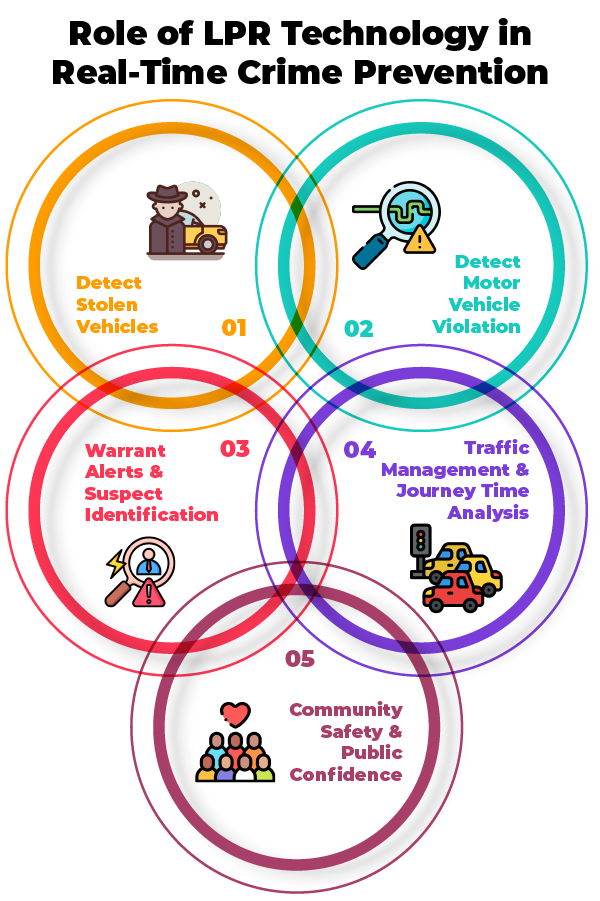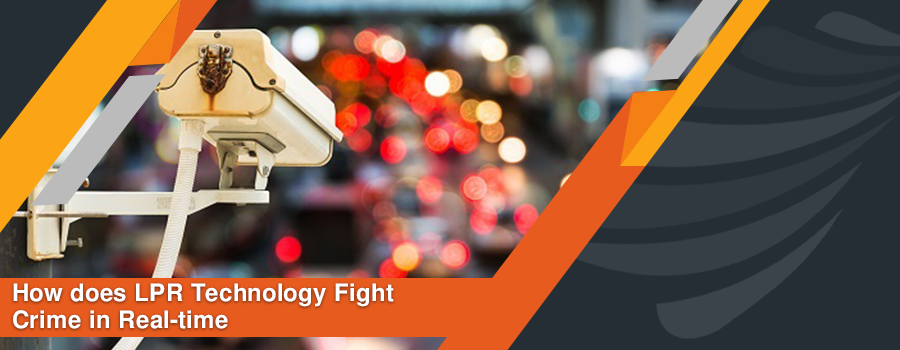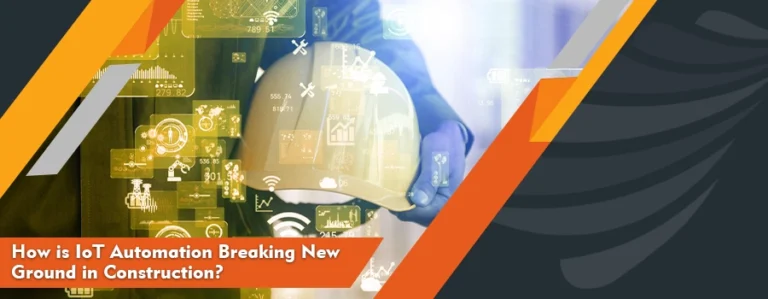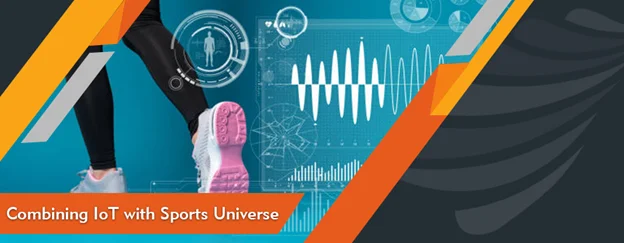Law enforcement agencies use cutting-edge technologies to stay one step ahead of criminal activity and constantly pursue safer communities. License Plate Recognition (LPR) technology shines like a light in this revolutionary era, providing unparalleled capabilities and real-time information in the battle against crime.
This blog tells the gripping story of how LPR technology actively fights against criminal activities rather than just keeping an eye on our streets as we delve into the complex web of security and innovation. Come to explore the ever-changing field of real-time crime prevention, where LPR technology transforms monitoring into a prompt and effective response.
What is License Plate Recognition (LPR) Technology?
Automatic license plate recognition (ALPR) or license plate recognition (LPR) technology is a sophisticated surveillance system that can scan, record, and comprehend license plate data from moving cars. The main parts of LPR technology are specialized cameras, optical character recognition (OCR) software, and databases for storing and interpreting the data gathered.

How Does License Plate Recognition (LPR) Technology Work?
Here is how LPR works:
1. Camera Capture
LPR systems take pictures of license plates on cars using high-resolution cameras, many of which have infrared capabilities. These cameras can be mobile and integrated into toll booths or police cars, or they can be stationary and attached to poles or other fixed structures.
2. Optical Character Recognition (OCR)
OCR technology processes the pictures taken and extracts the license plate’s alphanumeric letters. This method transforms visual information into machine-readable data.
3. Data Processing and Analysis
After the license plate data has been collected, it is processed and compared to databases that include details about interesting cars. These databases might contain lists of automobiles that have been reported stolen, are connected to criminal activity, or have active warrants.
4. Real-Time Identification
Because LPR systems run in real-time, cars can be identified as soon as they drive through the monitored region. This capability is especially helpful for law enforcement agencies reacting swiftly to threats or criminal activity.
5. Database Integration
LPR systems can be combined with several databases, including parking, toll collecting, and law enforcement databases. This integration’s additional context and data about the recognized vehicles improve the system’s efficacy.
Need of LPR to Reduce Crime Rate
The National Insurance Crime Bureau (NICB) has highlighted the problematic figures on vehicle theft, which show the necessity for License Plate Recognition (LPR) technology to lower crime rates. More than a million automobiles were reported stolen in the US in 2022—a 7 percent rise from the year before and a milestone reached for the first time since 2008. The alarming rise in car theft, especially in Texas and California, and the startling 35% increase in Illinois between 2021 and 2022 highlight the critical need for cutting-edge technologies like LPR.
LPR technology is incredibly useful for quickly identifying vehicles that have been reported stolen, supporting law enforcement with real-time tracking, and serving as a proactive deterrent. It plays a critical role in combating the increasing number of vehicle-related crimes, substantially contributing to overall efforts to improve public safety and reduce criminal activity.
Role of LPR Technology in Real-Time Crime Prevention
1. Detect Stolen Vehicles
LPR technology provides continuous real-time monitoring of vehicles in public spaces. By scanning license plates in real-time, law enforcement agencies quickly track vehicles linked to criminal records, such as missing persons, stolen cars, and others. LPR allows law enforcement agencies to speed up their progress in arresting auto thieves, reducing the frequency of such crimes.
2. Detect Motor Vehicle Violation
LPR devices regularly monitor roadway traffic, quickly transforming license plate images into useful data. This makes it possible for law enforcement to quickly find and deal with various traffic transgressions, such as speeding, red light infractions, and unauthorized entry. In addition to streamlining law enforcement operations, the smooth integration of LPR technology in automated traffic monitoring is a potent deterrent. It substantially contributes to the continuous quest for safer and more compliant roads.
3. Warrant Alerts and Suspect Identification
With integrated databases, LPR systems can cross-reference license plate information with lists of wanted vehicles, people with outstanding warrants, or vehicles linked to ongoing criminal investigations. Because of this real-time identification, police enforcement can take immediate action to deal with possible threats or detain offenders.
4. Traffic Management and Journey Time Analysis
LPR devices are essential tools used by transportation agencies and authorities. Critical data, such as vehicle speeds and congestion levels, can be collected and analyzed by strategically positioned nodes along particular road segments. Using this invaluable data, law enforcement agencies may more successfully enforce traffic laws, design and manage the road network infrastructure, and assist traffic administrators in creating more efficient routes. This technology’s automatic feature guarantees effective data collection without burdening financial or human resources, freeing departments to focus on other operational facets.
5. Community Safety and Public Confidence
The undeniable presence of LPR equipment in communities raises citizens’ feelings of security. People’s trust in local policing increases when they know law enforcement uses cutting-edge technology to prevent crimes in real-time.
Use Case of LPR Technology in Real-Time Crime Prevention
Using License Plate Recognition (LPR) technology is becoming essential to real-time crime prevention in today’s metropolitan security environment. One notable example of this revolutionary technology is OLIOS-LPR, an innovative and user-friendly LPR solution designed especially for parking enforcement in cities and universities.
OLIOS-LPR, which has demonstrated remarkable performance in Meshkati, Riyadh, and St. Pete Beach, Florida, is evidence of the effectiveness of LPR systems in improving security protocols and reducing criminal activity. This use case highlights the benefits of OLIOS-LPR by showing how its accuracy and user-friendly design support a proactive and flexible strategy for real-time crime prevention in urban settings.
Future Implications
The applications of License Plate Recognition (LPR) technology present both great opportunities and difficulties in the future. On the one hand, advances in artificial intelligence and machine learning could improve the speed and accuracy of LPR systems, making them even more useful for traffic control, public safety, and law enforcement.
Integrating smart city projects and the Internet of Things (IoT) may result in a more networked and effective urban transportation system. However, as LPR technology becomes more widely used, privacy problems must be carefully considered. Strong laws and ethical frameworks are required to ensure responsible deployment and protect people’s rights in the face of developing surveillance capabilities. As LPR technology continues to influence public security and urban administration, it will be imperative to balance technological innovation and privacy concerns.
Final Thoughts
LPR technology is essential to improving public safety since it can quickly and automatically identify vehicles linked to criminal activity, track stolen vehicles, and monitor traffic infractions in real-time. While applauding its efficacy, managing the privacy and ethical issues raised by its use is critical, guaranteeing a healthy balance between personal freedoms and technological progress. LPR technology is still a trailblazer for building safe and resilient communities because of its proactive and dynamic approach to crime prevention.





